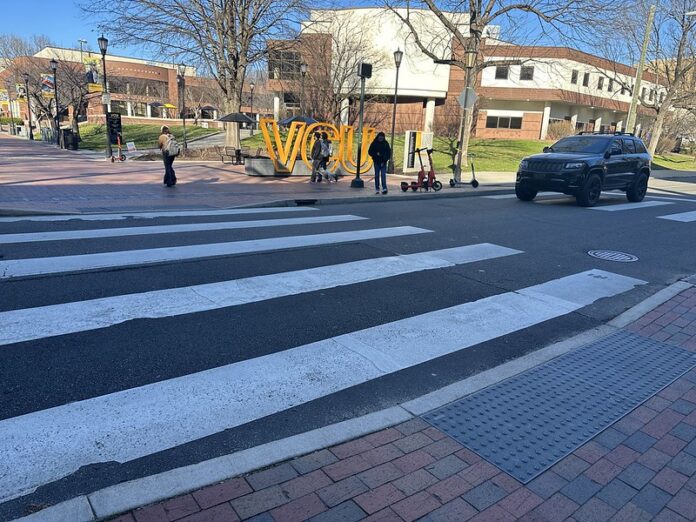Legislation did not advance that would allow universities the option to install school crossing zones on campuses, although pedestrian injuries continue to rise throughout the state.
Three measures were introduced to allow public and private institutions to be included in the definition of “schools” for crossing zones. Universities would be able to create a 25 mph speed limit and erect school crossing signs to improve pedestrian safety.
Virginia school crossing zones have been integral to minimizing accidents involving vehicles and pedestrians, according to Del. Betsy Carr, D-Richmond, who sponsored House Bill 1072. A similar proposal from Del. Mike Jones, D-Richmond, was incorporated into Carr’s bill.
Sen. Lamont Bagby, D-Richmond, sponsored Senate Bill 535, which advanced on a 23-17 vote. Two Republicans who represent districts that are near or include a college voted in support of the bill.
Both bills died once they hit the House Innovation subcommittee. Carr voted against Bagby’s bill in the House.
The proposals were labeled a “speed camera” issue. Another part of state code, passed in 2020, allows for speed cameras to monitor school crossing zones.
“In the House, no bills having to do with the photo speed cameras have been passed this session,” Carr said. “They’re putting them all to the side to study them and look at them.”
Although lawmakers recognize the concern over pedestrian safety, both sides of the political spectrum are opposed to speed cameras and believe there are other ways to help reduce traffic accidents, Carr said. People did not want to expand where speed cameras were used, until lawmakers looked more closely at it.
Bagby asked the subcommittee members to pass his bill in addition to any proposed study, because it was the “right thing to do, right now, to save lives.”
Lawmakers did not try to amend state code to just exclude universities from places where speed cameras are allowed. Carr did not respond to a followup request about why that was not proposed as a solution, since speed cameras were a concern with the legislation.
The patrons represent districts surrounding Virginia Commonwealth University, where two pedestrian fatalities occurred on campus last spring and prompted traffic changes.
The bill could help decrease the “rampant speeding” through campus, Carr said. The legislation was “birthed for VCU” and its unique urban campus with a main thoroughfare, Bagby told the House panel.
Pedestrian and bicycle-involved accidents and fatalities occur everywhere. There are several universities with campuses near busy streets and downtown areas, such as the University of Virginia in Charlottesville, Virginia Tech in Blacksburg and the University of Mary Washington in Fredericksburg.
The bills did not require an institution to install the crossing zones, or speed cameras, but they could have opted in.
Cyclist-involved fatalities increased last year, with 15 total, according to the state traffic database. The number of injuries increased almost 4%, with 678 total.
Pedestrian-involved fatalities decreased, with 137 total last year. But there was a 20% increase in the number of pedestrians injured, with 2,054 total.
Brantley Tyndall is director of Sports Backers’ Bike Walk RVA, an organization that supports policies good for bike and pedestrian safety. The organization supported both bills. “If you want to make a street safe for everyone, lower speeds,” Tyndall said. “And we should be exploring both policy and enforcement solutions,” Tyndall said.
Speed cameras are a complex issue for advocates and lawmakers, who worry if they are used equitably, according to Tyndall. They might not be familiar with how data is recorded or used, worry there could be unintended consequences, and impact communities of color, he said. “Truth be told, they can’t be used for other things,” Tyndall said. “We got that right in the original legislation back in 2020, but they might not really be comfortable with it.”
The cameras are proven to be one of the most effective methods to reduce speeding, which increases road safety for all, he said. “They are equitable in that they don’t choose who they find and who not they don’t find,” Tyndall said. “They don’t lead to police interactions, so they can’t escalate at the site of someone being pulled over, and they charge less money than getting a traditional moving violation.”
A couple of street safety bills survived crossover day and headed to the other chamber.
Another bill from Carr would allow cyclists to yield at an intersection instead of fully stopping at the sign. It passed the House on a party-line vote. A proposal that passed from the House with some bi-partisan support allows cyclists and motorized skateboarders to proceed on a red light, with conditions. And bicyclists would be allowed to again ride two abreast in a bill that almost did not pass the House.
By Thailon Wilson / Capital News Service


